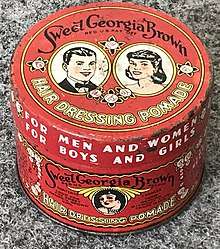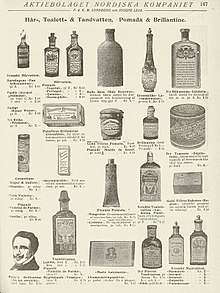Pomade
.jpg)

Pomade (/pɒˈmeɪd/; French pommade) is a greasy, waxy, or a water-based substance that is used to style hair. Pomade generally gives the user's hair a shiny and slick appearance. It lasts longer than most hair care products, often requiring multiple washes to completely remove. The original pomade of the eighteenth and nineteenth centuries consisted mainly of bear fat or lard. Lanolin, beeswax, and petroleum jelly have been used extensively in the manufacture of modern pomades. Stiffening properties of pomades make sculptured hairstyles such as the pompadour possible; while long lasting moisturizing properties make it popular with individuals with Afro-textured hair.
In perfumery, a pommade is a plant extract obtained by enfleurage.
Origin of the name
The English word "pomade" is derived from French pommade meaning "ointment", itself arising from the Latin pomum (fruit, apple) via the Italian pomata or pomo (meaning "apple"—as the original ointment recipe contained mashed apples).[1] Modern pomades may contain fragrances, but they are usually not particularly fruity.
History

During the Roman era, soap was used as a pomade by some European tribes.[2] In the 19th century, bear fat was usually the main pomade ingredient.[3] In 1873 UK company Morgan's Pomade was established ([4]) selling Hair Darkening Pomade across the World. By the early 20th century, petroleum jelly,[5] beeswax, and lard were more commonly used.[6] Early 20th century examples of pomades include Murray's Superior Pomade (originating in 1925),[7] Sweet Georgia Brown Hair Dressing Pomade (originating in 1934)[8] and Royal Crown Pomade (originating in 1936). Dixie Peach Hair Pomade was popular with teenage boys in the U.S. from World War II through the 1960s.
Pomades were much more popular in the 1920s to 1950s[9] than they are today, although they have made a comeback in the 2010s with recent alternations to the marketplace, which feature not only traditionally manufactured petrolatum and oil based pomades but also modern water-soluble pomades. Compared to oil based pomades, water-based pomades wash out more easily.
Modern hairstyles involving the use of pomade include the ducktail, pompadour, and quiff.
Use
Unlike hair spray and hair gel, pomade does not dry, keeps the hairstyle flexible and can last much longer. Pomade is used to style hair (including mustaches, sideburns, and beards), giving it a darker, slicker, shinier look, and is often associated with the slick men's hairstyles of the early to mid-20th century. Because of its greasy or waxy nature, pomade can last through several washings, although it is easily removed using de-greasers such as high-detergent shampoos, dishwashing liquids, or any shampoos designed for oily hair. Due to the difficulty of washing pomade out of the hair, water based and water-soluble pomades were introduced to the market and feature fewer wax substances. These products are more easily washable but often do not give the same versatility, shine, and strength of hold offered by the traditional petrolatum-based products.
Some pomade products, such as mustache wax, are marketed for a specific use, while products such as Ultra Sheen, are marketed for specific consumers. Pomade is often used with Afro-textured hair to keep it from drying out. All these products come in various textures and consistencies, and essentially achieve the same effect as either hair wax or pomade.
Difference between hair wax and pomade
Traditionally, the difference between hair wax and pomade was that pomade gave the hair a slicker, shinier appearance, while wax gave a looser, more texturized and matte finish. Today the difference between pomade and hair wax is becoming somewhat ambiguous especially since many heavier pomades contain beeswax. Hair wax and pomade are closely related, however, with pliability their main common property. This differentiates both wax and pomade from gel and hairspray, both of which are not designed to be restyled once the product is applied.
See also
References
- ↑ "Online Etymology Dictionary". Archived from the original on 2008-12-01.
- ↑ the Elder, Pliny. Natural History.
- ↑ J. K. Crellin (1994). Home Medicine. McGill-Queen's Press. p. 88.
- ↑ "Archived copy". Archived from the original on 2017-10-30. Retrieved 2018-01-10.
- ↑ Raymond Foss Bacon, William Allen Hamor (1916). The American petroleum industry. McGraw-Hill.
- ↑ Thomas William Cowan (1908). Wax Craft, All about Beeswax: Its History, Production, Adulteration, and Commercial Value. S. Low, Marston & co., ltd. p. 148.
- ↑ Murray's history Archived 2015-01-07 at the Wayback Machine.
- ↑ "Sweet Georgia Brown". Sweet Georgia Brown. Retrieved 2018-09-25.
- ↑ Soldan, Stan (2017). The Pomade-Book. Munich, Germany. p. 302. ISBN 978-3-9816789-2-5.
| Look up pomade in Wiktionary, the free dictionary. |
| Wikisource has the text of the 1911 Encyclopædia Britannica article Pomade. |